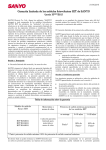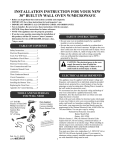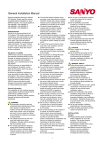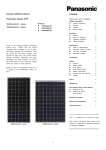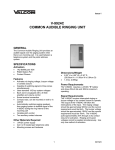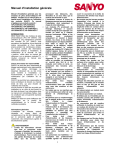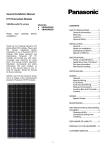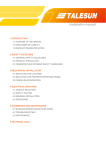Download General Installation Manual
Transcript
General Installation Manual General Installation Manual for SANYO HIT Photovoltaic Modules. Please read this manual completely before installation or use of SANYO modules. • This manual applies to the following products: HIT-H250E01, HIT-H245E01, HIT-H240E01, HIT-H250E02, HIT-H245E02, HIT-H240E02 • INTRODUCTION Thank you for choosing SANYO HIT photovoltaic (PV) modules. With proper operation and maintenance, SANYO HIT PV modules will provide you with clean, • renewable solar electricity for many years. This manual contains important installation, maintenance and safety information. The word “module” as used in this manual refers to one or more PV • modules. Retain this manual for future reference. • Disclaimer of Liability SANYO does not assume responsibility and expressly disclaims liability for loss, • damage, or expense arising out of, or in any way connected with installation, operation, use, or maintenance by using this manual. • SANYO assumes no responsibility for any infringement of patents or other rights of third parties, which may result from use of modules. No license is granted by implication or • under any patent or patent rights. The information in this manual is believed to be reliable, but does not constitute an • expressed and/or implied warranty. SANYO reserves the right to make changes to the product, specifications, or manual without prior notice. • General Information The installation of solar modules requires a great degree of skill and should only be performed by qualified licensed professionals, including, without limitation, licensed contractors and licensed • electricians. • • • WARNING All instructions should be read and understood before attempting to • install, wire, operate, and maintain the photovoltaic module. Contact with electrically active parts of the module such as terminals can result in burns, sparks, and lethal shock whether the module is • connected or disconnected. The installer assumes the risk of all injury that might occur during installation, including, without • limitation, the risk of electric shock. PV modules generate DC electrical energy when exposed to sunlight or other light sources. Although single modules produce only a low voltage and current, shocks and burns are still a potential hazard. To avoid the hazard of electric shock and injury, cover the entire front surface of the PV modules with a dense, opaque material such as a cardboard box, during installation and handling of the modules. The shock hazard increases as modules are connected in parallel, producing higher current, and as modules are connected in series, producing higher voltages. The shock hazard increases as modules with nominal open-circuit voltage (Voc) in excess of 50 V, and/or modules rated for maximum system voltage in excess of 50 V. To avoid the hazard of electric shock, work only in dry conditions, with dry modules and dry tools. Do not stand or step on a module to avoid the hazard of injury and damage to the module. Do not puncture or damage the back sheet of a module, to avoid the hazard of electric shock and fire. To avoid the hazard of electric shock and injury, children and unauthorized persons should not be allowed near the installation of PV modules. To avoid the hazard of electric shock and injury, be sure to completely ground all modules. To avoid the hazard of electric shock, fire, and injury, do not disassemble the module, or remove any part installed by the manufacturer. Unauthorized persons—except the qualified licensed professional— should not open the cover of the junction box to avoid the hazard of electric shock. Do not touch terminals while a module is exposed to light. Provide suitable guards to prevent yourself from direct contact with 30 VDC or greater to avoid the hazard of electric shock or injury. When carrying a module, two or more people should carry it by its frame and wear non-slip gloves (to avoid injury by a slipping module, to a foot, or cuts by the edge of a frame, and so on). Do not carry a module by its wires or junction box, to avoid the hazard of electric shock, injury or damage to the module. Do not drop anything on the surfaces of a module, to avoid the hazard of electric shock, injury, and damage. 1 • • • • • • • • • • • • To avoid the hazard of electric shock and fire, be sure that all other system components are compatible, and they do not subject the module to mechanical or electrical hazards. Since sparks may occur, do not install the module where flammable gases or vapors are present. Never leave a module unsupported or unsecured. Do not drop a module. Do not use or install broken modules to avoid the hazard of fire, electric shock, and injury. Do not artificially concentrate sunlight on a module to avoid the hazard of fire or damage. Do not touch the junction box terminals to avoid the hazard of electric shock and injury. Do not change the wiring of bypass diodes to avoid the hazard of electric shock and injury. Do not disconnect terminals while PV modules generate electricity and connect electrical load to avoid the hazard of electrical shock. Do not touch a PV module unnecessarily. The glass surface and frames get hot. There is a risk of burn. CAUTIONS Use a module for its intended purpose only. Do not treat the back sheet or front surface with paint or adhesives, to avoid reducing its’ functionality, damage, inoperable conditions, and other unknown troubles. GENERAL SAFETY Follow all permission, installation and inspection requirements. • Before installing modules, contact the appropriate authorities to determine permissions, installation and inspection requirements, which should be followed. • Be sure that the construction or structure (roof, etc.) where the modules are being installed has enough strength. • For modules mounted on roofs, special construction or structures may be required to help provide proper installation support. • Both roof construction and module installation design have an effect on the fire resistance of a building. Improper installation may contribute to fire hazards. Additional devices such as ground fault, fuses, and disconnects may be required. General Installation Manual • Do not use modules of different specifications in the same system. • Follow all safety precautions of other system components used. INSTALLATION General • Please read this guide completely before installation or use of the modules. This section contains electrical and mechanical specifications needed before using your SANYO PV modules. • Modules should be firmly fixed in place in a manner suitable to withstand all expected loads, including wind and snow loads. • Please do not touch the glass surface of modules to protect from dirt, because the glass surface is coated. (If the glass surface becomes dirty, see section of MAINTENANCE.) • The drilling and addition of ground holes is permitted, but should be avoided whenever possible to avoid damage to the module. When additional ground holes are necessary, they must not penetrate the inner side of the aluminum frame. Caution is advised to avoid accidentally drilling, scratching, or penetrating the back sheet surface of the module. If required, it is recommended to add additional ground holes to the outer aluminum lip area of the module. In such case, additional ground holes must be at least 65 mm away from any frame corner. • For a non-integral module or panel, the assembly is to be mounted over a fire resistant roof covering rated for the application. • Appropriate material should be used for mounting hardware to prevent the module frame, mounting structure, and hardware itself from corrosion. • Install modules where they are not shaded by obstacles like buildings and trees. Especially pay attention to avoid partially shading the modules by objects during the daytime. • Please contact your SANYO Authorized Representative with questions regarding mounting profiles for modules if needed. Notes on Installation • Clearance of “10 cm” between the roof surface and module frame is required to allow cooling air to circulate around the back of the module. This also allows any condensation or moisture to dissipate. Install modules so that air can circulate between the roof and the module. • We recommend installation methods shown in Figure 1. In some areas, • local electrical codes may govern the installation and use of PV modules. To avoid the hazard of the electric shock and fire, do not contact and 2) damage the back sheet of the module 3) with mounting bolts.. Operating Conditions SANYO recommends that modules be operated within the following Operating Conditions. An installation location with conditions beyond the Operating Conditions or with other Special Conditions (see below) should be avoided. Operating Conditions of SANYO modules are as follows: 1) The modules should be operated only in terrestrial applications. No space or other Special Conditions (see below). 2) The ambient temperature should be within –20°C (-4°F) to 40°C (104°F). 3) The relative humidity should be within 45% to 95%. 4) The wind pressure load of the installation site should be less than 2,400N/m2 (50PSF). Special Conditions 1) The ambient temperature 4) 5) installation place are different from the recommended Operating Conditions. Salt damage is severe at the installation place. Hail and snow damage is excessive at the installation place. Sand and dust damage is excessive at the installation place. Air pollution, chemically active vapors, acid rain, and/or soot, etc. are excessive at the installation place. SPECIFICATIONS Notes on Specifications 1) Rated electrical characteristics are within 10% of the values measured at Standard Test Conditions (STC). 2 o Irradiance of 1000W/m , 25 C cell temperature, and solar spectral irradiance per IEC 60904-3. 2) Under normal conditions, a photovoltaic module may experience conditions that produce more current and/or voltage than reported at standard test conditions. Accordingly, the values of Isc and Voc marked on this module should be multiplied by a factor of 1.25 when determining and Installation (reference) For questions regarding mounting profiles for modules, please contact your local dealer. Solar Module A Mounting Structure Rail A Solar Module Section A-A M6 Bolt Spring washer Flat washer Flat washer Spring washer M6 Nut Module Mounting Structure Rail Figure 1: Installation 2 General Installation Manual component voltage ratings, conductor • Do not connect modules in parallel current ratings, fuse sizes, and size of without using a connection box. controls connected to the module • Do not disconnect terminals while PV output. modules generate electricity and 3) The current output for the modules connect electrical load to avoid the shown in the Specifications is hazard of electrical shock. measured at Standard Test • To avoid the hazard of electric shock Conditions. These conditions may and sparks, please connect each not be frequently observed in actual cable after confirming the polarity of practice. them is correct. • Cable conduits should be used in Application class of product locations where the wiring is SANYO HIT PV-modules are applied to inaccessible to children or small application class A. Application class A for animals. PV-modules are defined as follows: Class A: General access, hazardous Module Wiring voltage, hazardous power applications • The maximum number of H-type Module rated for use in this application modules that can be wired in series is class may be used in systems operating at twenty (20). greater than 50 V DC or 240 W, where • Modules shall not be wired in parallel general contact access is anticipated. without maximum over current Modules qualified for safety through this protection. part of IEC 61730-1 and IEC 61730-2 and • When installing a PV array, the within this application class are system design must be completed considered to meet the requirements for with reference to the module electrical safety class II. specifications for proper selection of inverters, fuses, breakers, charging Fire class of product controllers, batteries and other Sanyo HIT PV modules fill the fire class C storage devices. that provides to ANSI/UL790. Class C roof • These modules contain factory coverings are effective against light fire installed bypass diodes. If these test exposures. Under such exposures, modules are connected each other roof coverings of this class afford a light incorrectly, the bypass diodes, cable, degree of fire protection to the roof deck, or junction box may be damaged. do not slip from position, and are not expected to produce flying brands. Array Wiring • The term “array” is used to describe Mechanical Loading the assembly of several modules on a • The modules should be mounted support structure with associated basically at the four (4) quarter points wiring. by the means shown in Figure 2-1. • Use copper wire that is sunlight However, you may choose the resistant and is insulated to withstand optional mounting ranges (with the maximum possible system open limitation of fixing span) by means circuit voltage. shown in Figure 2-2 or Figure 2-3. • Check your local codes for • This method offers a maximum load requirements. of 2400N/m2 (50PSF, in a static state) on the module surface. Earth Ground Wiring • The kind of the earth construction CERTIFICATION shall conform to IEC61730-1. The HIT-HxxxE01, HIT-HxxxE02 Modules Bonding shall be by a positive means, comply with the requirements of IEC61215, • such as clamping, riveting, bolted or IEC61730-1, IEC61730-2 and the CE screwed connections, or welding, mark. soldering or brazing. The bonding connections shall penetrate all nonWIRING conductive coatings, such as paint, General anodized coatings or vitreous enamel. • All wiring should be done in • A wiring terminal or bonding location accordance with applicable electrical of module intended to accommodate codes. a field installed equipment-grounding • All wiring should be done by a conductor shall be identified with the qualified, licensed professional. appropriate symbol (IEC 60417• Wiring should be protected to help 5019(DB: 2002-10)) or shall have a ensure personal safety and to prevent green-colored part. its damage. • Grounding should be carried out by • All modules connected in series the attachment to the module or array should be of the same model number frame, to avoid the hazards of electric and/or type. shock or fire. 3 Module Terminations • A junction box as a terminal enclosure is equipped for electrical connections on SANYO modules. TM • Modules are equipped with MC plugs as a terminal enclosure. Use TM plugs for electrical these MC connections. • If two or more separable connectors are provided, they shall be configured or arranged so that the other and vice-versa will not accept the mating connector for one, if it will result in an improper connection. • Please contact your SANYO Authorized Representative with questions regarding other electrical connections if needed. Junction Box and Terminals • Modules equipped with one junction box contain terminals for both positive and negative polarity, and bypass diodes. • One terminal is dedicated to each polarity (with the polarity symbols engraved onto the body of the junction box) (see Figure 3). Conduit • For applications where wire conduits are used, follow the applicable codes for outdoor installation of wires in conduits. Minimum diameter of wire 2 conduit is 4.0 mm . • Verify that all fittings are properly installed to protect wires against damage and prevent moisture intrusion. DIODES Bypass Diodes • When the modules in series strings are shaded partially, it may cause reverse voltage across cells or modules, because the current from other cells in the same series is forced to flow through the shaded area. This may cause undesirable heating to occur. • The use of a diode to bypass the shaded area can minimize both heating and array current reduction. • All SANYO modules are equipped with factory installed bypass diodes. The factory installed diodes provide proper circuit protection for the systems within the specified system voltage, so that you do not need any other additional bypass diodes. • Specifications of bypass diode for HIT-HxxxEyy module are as follows; Bypass diode rating: 30A, 45PIV (Peak Inverse Voltage), Number of bypass diode: 3 diodes, Number of series cells per bypass diode: 96 cells / diode (1st and 3rd block), 48 cells / diode (2nd block) (See Figure 4). General Installation Manual • Contact your SANYO Authorized Representative for proper diode type, if it is necessary to add or change diodes due to system specifications. MAINTENANCE • Some maintenance is recommended to maintain optimal output performance of the solar modules. • If the module surface becomes dirty, it may reduce output power. • It is recommended to clean the surface of the module with water and a soft cloth or sponge. • To remove persistent dirt, the module can be washed with a micro-fiber cloth and ethanol. • Alternatively, a mild detergent may be used. Never use abrasive detergent, strong alkaline detergent and strong acid detergent to clean any part of the module. • It is also recommended to inspect the electrical and mechanical connections annually. • If you need electrical or mechanical inspection or maintenance, it is recommended to have a licensed authorized professional carry out the inspection or maintenance to avoid the hazards of electric shock or injury. • The return of any modules will not be accepted by SANYO unless prior written authorization has been given by SANYO. • As part of our policy of continuous improvement SANYO reserves the right to change product specifications at any time without prior notice. For further information, please visit www.sanyo-solar.eu or www.sanyo.com or contact a SANYO Authorized Representative. © 2011 Sep. SANYO Electric Co., Ltd. All Rights Reserved 9/6/2011 4 General Installation Manual SPECIFICATIONS Standard Models – HIT-HxxxE01, HIT-HxxxE02 E lectrical S pecifications V HIT-H250E01 HIT-H250E02 60 240 250 34.9 7.18 43.1 7.74 HIT* 1000 HIT-H245E01 HIT-H245E02 60 240 245 34.4 7.14 42.7 7.73 HIT* 1000 HIT-H240E01 HIT-H240E02 60 240 240 33.8 7.11 42.3 7.72 HIT* 1000 A 15 15 15 Model Cell Number in Series Total cell n umber Rated Power, Watts (Pmax) Maximum Power V oltage (Vpm) Maximum Power Current (Ipm) Op en Circuit V oltage (Voc) S hort Circuit Current (Isc) Cell Type Maximum System V oltage (Voc) Maximum over-current protection rating Factory Installed Bypass Diodes W V A V A 3 3 HIT* : Hetero junctio n wi th Intrinsi c Thin-layer 3 Mechanical Specifications HIT-H250E01 HIT-H250E02 Model Leng th Width Height Weight mm mm mm kg HIT-H245E01 HIT-H245E02 861 HIT-H240E01 HIT-H240E02 1610 35 16.5 Dimensions Dimension in mm A-A’ Section B-B’ Section 0.2 -B5 5 0V PVU IP6 100 0.2 -B5 PVU Junction box Mounting Places (4 places) Note: In case of installation on a rail structure, modules must be attached within the depicted shaded range. Figure 2-1: Dimensions 5 General Installation Manual Optional Mounting Range Optional Mounting Range Dimension in mm Dimension in mm Note: Fixing span is 1050mm or less. Note: Fixing span is 1050mm or less. Figure 2-2: Optional Mounting Range Figure 2-3: Optional Mounting Range 2 . 0 5 B U V P 1st. Block 96cells / diode 3rd. Block 96cells / diode 2nd. Block 48cells / diode Cable Connector (MC Plug) Figure 4: Number of series cells per bypass diode Negative (-) Positive (+) Figure 3: Configuration of Junction box 6







